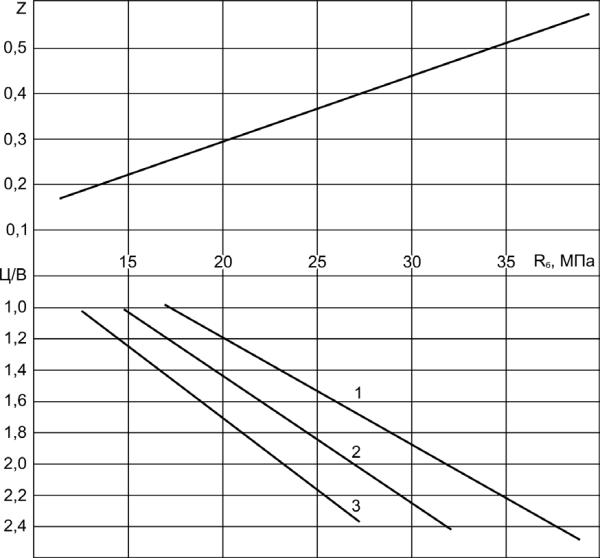,
(9.
2)
Den
W + P V + V
a a
air
Where V , W, V , V
are
c
a
air
Com pressive strength of
expanded clay concrete, M Pa
correspondingly absolute volumes of
Fig. 9.1 Effect of bulk density of aggregate
cement, water, porous aggregate and air
on density and strength of expanded-clay
per 1 m3 of concrete mix, P is aggregate
concrete on porous and quartz sand.
a
O n expanded clay sand at bulk density of
porosity.
expanded clay gravel, kg/m 3:
1 – 300; 2 – 400; 3 – 500; 4 – 600; 5 – 700; 6 –
800;
O n quartz sand at bulk density of expanded clay
gravel, kg/m 3:
7 – 300; 8 – 400; 9 – 5--; 10 – 600; 11 – 700;
12 - 800
173






Z
Reference books and
0.5
experimental data
processing (Fig. 9.2)
0.4
has shown that
0.3
strength of lightweight
concrete on porous
0.2
aggregates is
0.1
connected with Z
R
parameter by linear
C/W
c, MPa
dependence.
1.0
1.2
1.4
1.6
1.8
2.0
2.2
2.4
Fig.9.2. Strength (Rc) dependences of structural expanded clay
concrete on cement-water ratio (C/W) and modified cement-water
ratio (Z):
1 – porosity of expanded clay = 0.4; 2 – 0.55; 3 – 0.7
174





9.2. Design of lightweight concrete with porous aggregates
Design of lightweight concrete is oriented on preliminary determination of
components content that provides obtaining specified parameters at given
conditions. In all cases design of lightweight concrete with compressive
strength must provide specified density.
Design of lightweight concrete can be done:
- at specified types of coarse and fine aggregates with given values of their
density;
- at specified type and density of coarse porous aggregate with possible
selection of sand type;
- at selection both coarse and fine aggregates.
Selection of coarse porous aggregate is conducted on the basis of empirical
data that link their bulk density with density (ρ ) and strength of concrete
c
(R ).
c
175





Statistical treatment of known experimental data shows the possibility of
connection equation application:
R
= 0.008 b
ρ −1



















